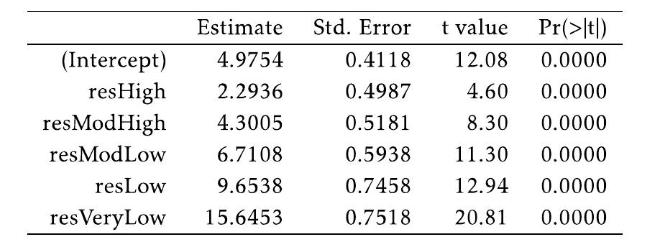The American Psychological Association defines resilience as the process of adapting well in the face of adversity,
Question:
The American Psychological Association defines resilience as "the process of adapting well in the face of adversity, trauma, tragedy, threats, or even significant sources of stress". Studies have suggested that resilience is an important factor in contributing to how medical students perceive their quality of life and educational environment.
Survey data were collected from 1,350 students across 25 medical schools. At each school, 54 students were randomly selected to participate in the study. Participants completed questionnaires measuring resilience, quality of life, perception of educational environment, depression symptoms, and anxiety symptoms.
The following regression model was fit to analyze the relationship between resilience and depressive symptoms. Resilience was categorized as: very low, low, moderately low, moderately high, high, and very high. Depressive symptoms were measured on a scale of 0 to 63 points, with higher scores indicating either more numerous or more severe depressive symptoms; this questionnaire is called the Beck Depression Inventory (BDI).
In this model, the residual standard error is 5.867 , the \(F\)-statistic is 118.1 with 5 and 1344 degrees of freedom; \(P\left(F_{5,1344}>118.1\right)<0.0001\).
(a) Describe the overall trend in language accessible to someone who has not taken a statistics course.
(b) Does the intercept have a meaningful interpretation? Explain your answer.
(c) Compare the predicted mean BDI score for someone with low resilience to that of someone with very low resilience. (d) + (e) Continue to the next page for parts (d) and (e).
(d) Assess whether level of resilience, overall, is associated with depressive symptoms as measured by BDI score. Be sure to include any relevant numerical evidence as part of your answer.
(e) A model was fitted predicting BDI score from resilience, with the categories numerically coded from 1 to 6 , with 1 being very high resilience and 6 being very low resilience. This model has a single slope estimate of 2.76 with \(p\)-value \(<0.0001\).
i. Using this model, compare the predicted mean BDI score for someone with low resilience to that of someone with very low resilience. Compare this answer to the one from part (c).
ii. What does this model imply about the change in mean BDI score between groups?
iii. Explain why this model is flawed.
Step by Step Answer:

Introductory Statistics For The Life And Biomedical Sciences
ISBN: 9781943450121
1st Edition
Authors: Julie Vu, David Harrington





